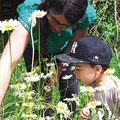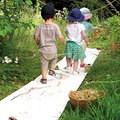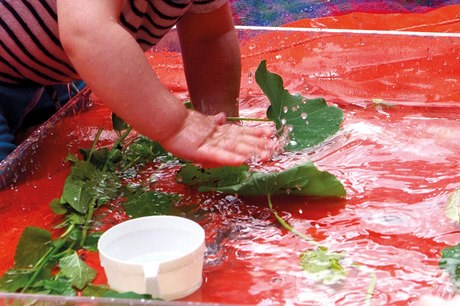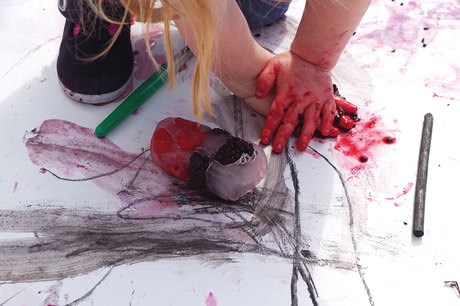Enabling Environments: Creativity - Open secret
Annette Rawstrone
Monday, August 7, 2017
A nursery in Wiltshire used a local garden in an old churchyard, and a visual artist, to put together a Making Memories project. Annette Rawstrone explains

A Secret Garden is tucked away in the heart of the city of Salisbury, just a short walk from First Steps Nursery. This hidden jewel was picked by the nursery as the perfect setting for a Making Memories creative project to celebrate its 25th anniversary.
‘Instead of looking back for our anniversary, we wanted to look forward with the children and help them to create memories,’ explains projects and development manager Leigh Chalmers. ‘The Secret Garden is the most beautiful space in an old churchyard and the garden has grown up around the gravestones. It’s a pocket of peace, with flowers and secret hidden spaces for the children to explore – the perfect venue for children to come and learn about heritage and wildlife in a playful, magical way.’
First Steps approached visual artist and creative consultant James Aldridge to collaborate on its Making Memories project. It is the fourth time they have worked together. Mr Aldridge believes that people are happiest and learn best when they are supported to explore the world around them.
‘His concept is to stand back, let the children explore what they want and support them, he is a great role model to the staff,’ says Ms Chalmers. ‘It’s not just drawing and mark-making but throwing rope over branches, making pulleys and measuring distance. The sharing of ideas and language and communication is brilliant. The opportunities for learning through art are massive and we’re always astonished.’
WELCOMING YET WILD
 For the Making Memories project the artist, children of all ages and staff explored the Secret Garden, engaged in creative activities there and made artwork in response to the garden in sessions back at the nursery. ‘The Secret Garden has a very welcoming, safe and yet wild feel to it,’ says Mr Aldridge. ‘There are handwritten signs on pieces of wood and tile, and gravestones and pieces of masonry lie about in the undergrowth. The children really feed off of this dual sense of safety with warmth and a tangled, crumbling history.’
For the Making Memories project the artist, children of all ages and staff explored the Secret Garden, engaged in creative activities there and made artwork in response to the garden in sessions back at the nursery. ‘The Secret Garden has a very welcoming, safe and yet wild feel to it,’ says Mr Aldridge. ‘There are handwritten signs on pieces of wood and tile, and gravestones and pieces of masonry lie about in the undergrowth. The children really feed off of this dual sense of safety with warmth and a tangled, crumbling history.’
The project, which started in May, focused on enabling each child to identify their own interests and to investigate them through making. It is culminating with an exhibition at Salisbury Arts Centre in August, concentrating on the nursery’s explorations and the relationship between the outdoors and childhood memory.
Parents were also involved in the project, which launched with everyone gathering to plant a mulberry tree in the Secret Garden.
They were also invited to an evening session where they were told about the project and invited to explore some of the materials that their children would be using.
‘It allowed the parents to step in to their children’s shoes and see what they’d be presented with,’ says Ms Chalmers. ‘Some parents commented how they’d forgotten how to play, how much they enjoyed it and that they should sit and draw with their children more often. The parents left excited about the possibilities their children would have.’
They were asked to document the children’s creative outdoor play at home to include in the project.
The children had five visits to the Secret Garden and, as well as exploring the grounds, had the opportunity to investigate different resources such as scented clay, water, charcoal, magnifying glasses and boxes to collect any ‘treasures’ they found.
 ‘We asked the staff to allow the children to explore and be behind them rather than leading. We wanted them to listen and ask leading questions, to capitalise on what the children were interested in and not stop the flow,’ Ms Chalmers explains.
‘We asked the staff to allow the children to explore and be behind them rather than leading. We wanted them to listen and ask leading questions, to capitalise on what the children were interested in and not stop the flow,’ Ms Chalmers explains.
Some of the staff had worked in that way on previous projects, but others were less familiar with the child-led way of working. ‘It took a while to embed, with some staff saying not to do things or instructing children what they should draw,’ reflects Mr Aldridge.
‘I think some staff were unsure of their role and needed to gain the confidence to just go along with the children and enjoy the journey. They need to stop feeling the pressure to generate certain outcomes and I hope this project will have helped them to be more observational and reactive.’
BUGS, ROBINS AND MUD
Children went on bug hunts, followed robins, looked at petals through magnifying glasses, painted with mud (see case study), rolled sticks and cones in clay and went on adventures. ‘The garden feels wild and undiscovered and children were given the role of explorer, which gave them a sense of freedom and agency,’ explains Mr Aldridge.
Continuing a theme from a previous project, the children also explored edible leaves and herbs. The babies had a blanketed area in the garden and staff looked at what would be safe to explore with their mouths and use for mark-making. They particularly enjoyed the multi-sensory experience of berries, flowers and herbs frozen in ice.
Staff noticed that many children were interested in pathways. They were given the resources to create their own paper pathways in the Secret Garden and at nursery. Pre-school children were fascinated by wrapping and tying objects and exploring height and length, which led to them making a rope swing. Others were interested in what animals lived in the garden, so Mr Aldridge installed night cameras, but unfortunately, all they captured were cats. They discussed foxes and hedgehogs and the children enjoyed animal role play with masks.
SEEING THE POTENTIAL

Back in the nursery, staff, supported by the artist, tried to bring some of the riches found in the Secret Garden into the nursery’s Tarmac yard. ‘We introduced different textures and smells such as compost and fresh herbs, feathers and large-scale mark-making materials, while inside we played bird song to try and bring some of the outdoors in,’ says Mr Aldridge.
As a result of the project, staff are now seeing the potential of the nursery’s small outdoor area and are in the process of improving it. They have got lots of plants in pots with casters on the base so that they can be moved to create secret spaces, section off areas for mark-making or role play or be pushed to the side to allow children to run and play ball games.
‘I can see how excited and engaged the children are and what a rich experience it has been for them,’ reflects Mr Aldridge. ‘A key thing about the work I do with First Steps is that it’s not just working with children but also with the staff and parents to enable it to continue. It’s not a parachute project but a legacy.’

He is now planning the exhibition with Ms Chalmers, which will predominantly be photographs, text and quotes to document the process that the nursery went through. ‘There will be things that the children made but the actual end product is the memory of the moment, rather than finished artwork. The shared moments and the learning and fun that they had,’ says Ms Chalmers.
‘We are also planning on taking the photos and children back to the Secret Garden in the autumn so that they can see the changes that have happened in the garden since spring. It will be another memory that they are creating.’
CASE STUDY: RAFE AND ISAAC
‘Three-year-old Rafe looked so happy just to be in the Secret Garden. He is a quiet boy who attends nursery one day a week and is often content to play by himself. Rafe was very focused in the garden on painting with a mixture of clay and water onto a big sheet of white paper. It was a tactile, sludgy mixture and he had a clear idea of what he wanted to do with it. He was very peaceful and immersed in his explorations,’ observes projects and development manager Leigh Chalmers.
She adds, ‘Rather than paint on paper, three-year-old Isaac covered himself up to the armpits in mud. He was like a little pig in mud and some of the staff were alarmed, but it was a very sensory, purposeful experience, rather than an accident. He then used his whole limbs to transfer the mud paint to the paper with large sweeping motions.
‘The boys were absorbed and only stopped when they heard the mention of a dragonfly by the pond – the word “dragon” caught their attention. They then spent the next ten minutes looking for dragons.’
MORE INFORMATION
The Making Memories exhibition is at Salisbury Arts Centre from 5 August to 16 September. Visitors will have the opportunity to share their own memories of times spent playing and learning outside, www.salisburyartscentre.co.uk
‘Edible art’ by Marianne Sargent
James Aldridge, www.jamesaldridge-artist.co.uk




